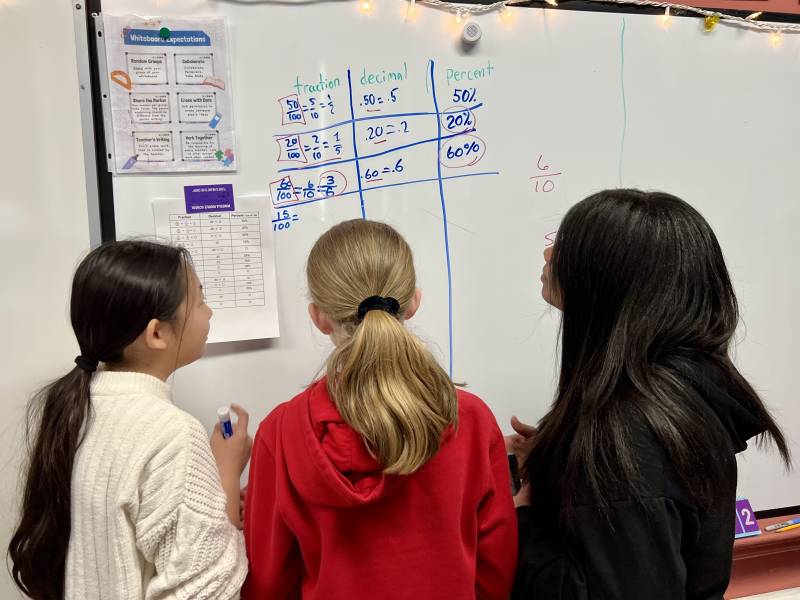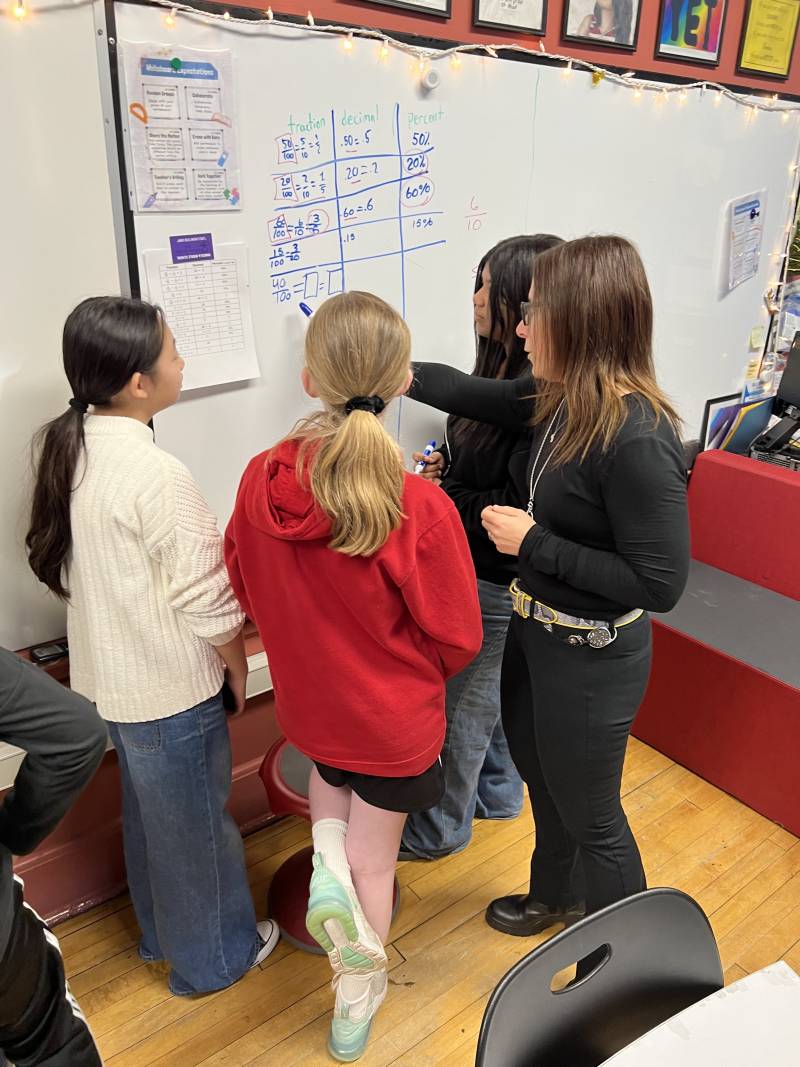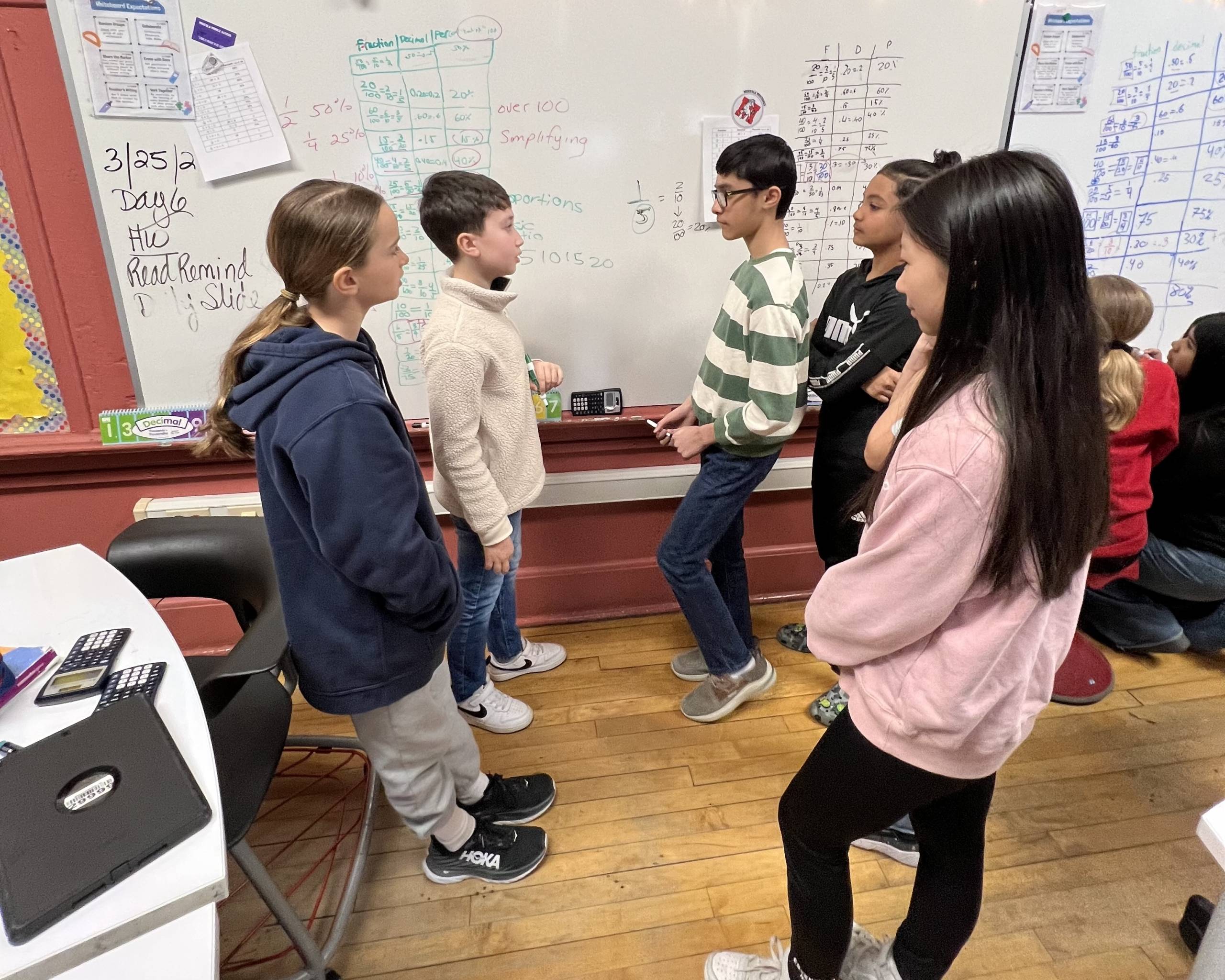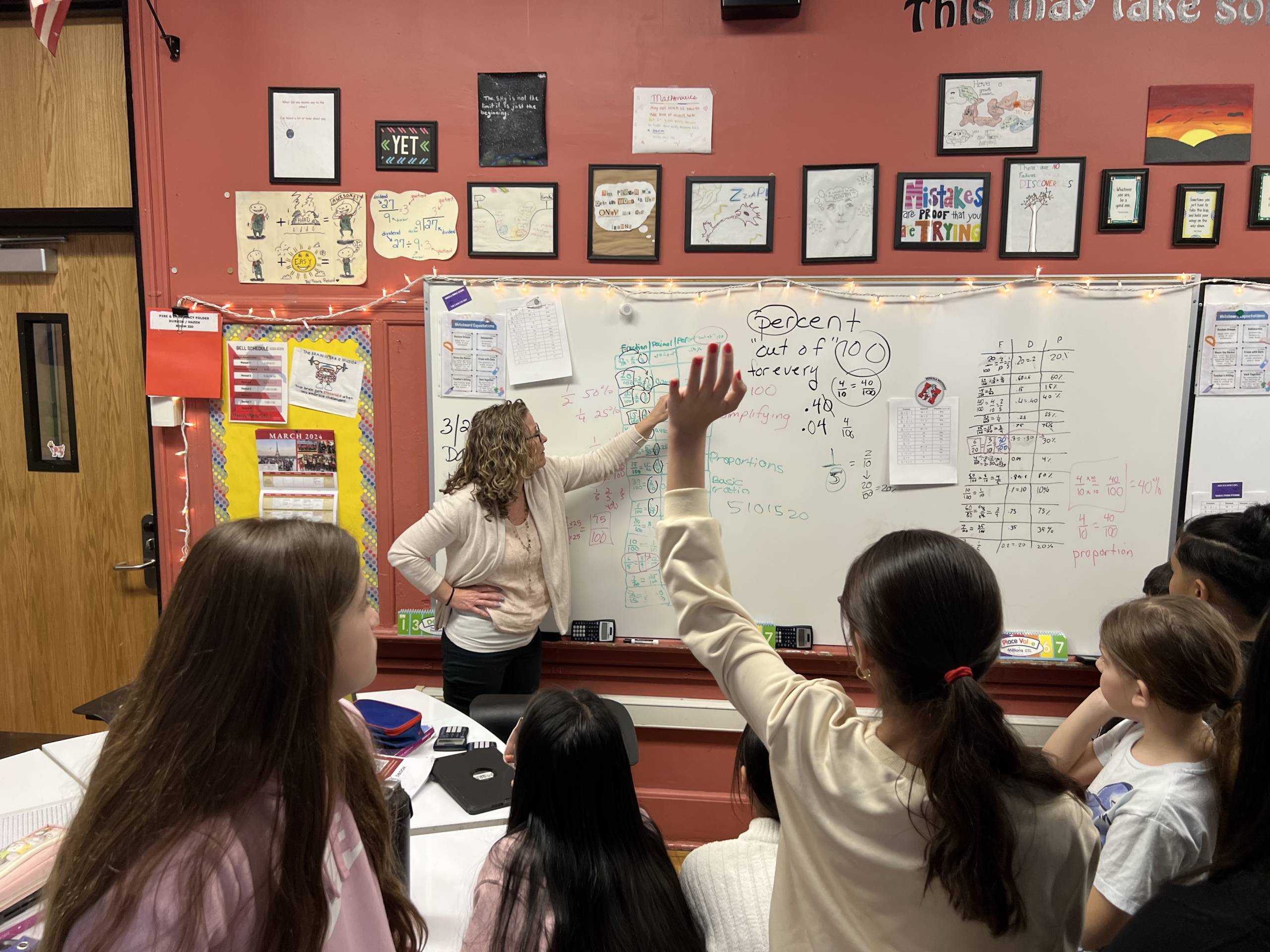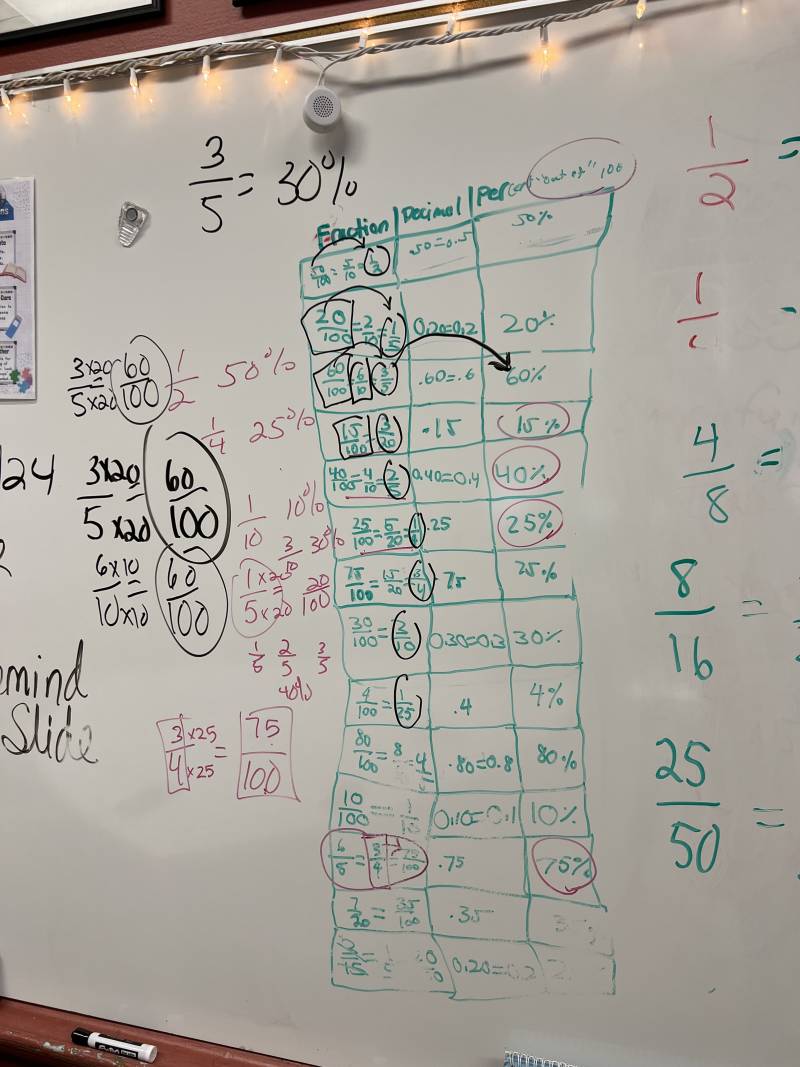“It’s a great way to enculture [students] into a new way of being,” Liljedahl said. “They might perceive that mathematics is different. They might perceive that you as a teacher is different, and that this is a safe space to engage in thought and collaboration. So we’ve just created sort of an aside — a safe space where students can be different and become different.”
In the usual culture of math class, where hierarchy is pervasive, it’s common to hear kids say they’re “not a math person.” But seven months into their thinking classrooms experience, Durnin’s students had no problem identifying their strengths in math. Here’s what a few of them said:
- “I’m good at factor puzzles and proportions and dividing fractions because I feel like I worked on those the most. So I’m really confident with those.” – Alexis
- “I think I’m good at math ’cause I can teach people like this certain strategy, or if they’re having trouble with the question. But sometimes I do struggle, like everybody else.” – Thayla
- “I just love problem solving. If I really want to do something, I’ll just focus my mind on only that and then block out everything else I’m working on.” – Chloe
As the school year wrapped up in June, Durnin said that her classes showed a deeper understanding of sixth grade math than students did in her many years teaching with more traditional methods.
Durnin also said it took a lot of work to for her to adapt her lesson plans but that the change in student engagement was worth it. Along the way, she sought help from a Facebook group where educators ask questions and share stories about thinking classroom practices every day. The group has over 66,000 members.
“I don’t think this is one of those teacher trends or a fad,” said McMellan, the Texas teacher. “It’s just good practices. And I think that’s what we’re all trying to find.”
Episode Transcript
Staci Durnin: What does percent mean?
[Music]
Kara Newhouse: Welcome to MindShift, where we explore the future of learning and how we raise our kids. I’m Kara Newhouse.
Nimah Gobir: And I’m Nimah Gobir.
Kara Newhouse: It would be an understatement to say that teachers have a lot on their plates right now.
Nimah Gobir: From book bans to chronic absenteeism to phone distractions, the list of challenges is long. And a lot of teachers are feeling the burnout.
Kara Newhouse: Which is why I was surprised when I started hearing a different refrain from math teachers. They were telling me that they’re more excited to go to work than ever – because their students are more excited than ever.
Staci Durnin: It’s just a lot of up out of the seats talking, collaborating. The kids are walking around the room, they’re working and they’re having fun.
Amber McMellan: And it’s really powerful to, to, to be able to walk around and, and just hear the conversations that the students have. It’s it it’s like food for the teacher heart, you know.
Kara Newhouse: These teachers are talking about a new approach to math called “thinking classrooms.”
Nimah Gobir: In this model, students work standing up at whiteboards in different small groups every day.
Kara Newhouse: It’s centered around a core idea: getting kids to think instead of mimic in math class.
[Music]
Peter Liljedahl: What teaching math so often has become is let me show you how to do it, and then you do it. Right. It’s sort of this ‘I do, we do, you do.’ And you’re going to learn to mimic these sorts of routines and practices.
Kara Newhouse: That’s Peter Liljedahl, the researcher who created the thinking classrooms model. Peter says that problem solving is “what we do when we don’t know what to do.” And we don’t usually let kids hang out in that space.
Peter Liljedahl: There’s been an agenda around teaching math through problem solving and teaching problem solving for 35 years now. But in order to do that, to really embrace that, to, if we really want to have students learning through problem solving, then they have to get stuck, and they have to think, and they have to get unstuck.
Kara Newhouse: Peter’s book, Building Thinking Classrooms in Mathematics, was published in 2020. It couldn’t have come at a better time.
Nimah Gobir: Getting kids excited about math has never been easy. And COVID didn’t help. Even now, a few years after distance learning, teachers of all subjects are struggling to get students engaged.
Kara Newhouse: So what makes thinking classrooms different? In this episode, we’ll visit a Long Island school where you’ll hear some of the key practices in action. And we’ll examine how these practices get kids thinking instead of mimicking in math. That’s all after the break. Stay with us.
Staci Durnin: OK. If you could take out a marker.
Kara Newhouse: This is Staci Durnin’s grade six math classroom at Mineola Middle School in New York. Today students are learning about percentages. They start with a question that puts percentages in a familiar context.
Staci Durnin: Okay, so you have 75% battery life on your phone or your iPad, and somebody else has one half of their battery life left. Who has more battery life? And how do you know? Can you show the work on your tabletop?
Kara Newhouse: Staci and her co-teacher read Building Thinking Classrooms over the summer. They decided to try out the practices from the book in the new school year.
Luke: Um, half of 100 is 50, making 75% more.
Staci Durnin: Why did you choose to use this percent?
Luke: Oh, because, for your phone, the max percent is 100%.
Staci Durnin: So half of 100% is 50%? And clearly, this is greater than this. Good. Anybody want to explain it differently?
Kara Newhouse: This opening problem only takes a few minutes. There’s no big lecture. Instead, students are going to try working with percentages right away. In his research, Peter Liljedahl has found that students do a lot more thinking when they get started on math problems quickly.
Nimah Gobir: That’s because when students start the lesson in a passive mode, it’s very hard to switch into a more active mental state.
Kara Newhouse: Peter recommends that teachers only pre-teach a topic for three to five minutes, max. Then students work on math problems standing up at whiteboards, in groups of 3.
Staci Durnin: All right. So we’re going to hear our groups right now. Go find your board space and get working.
Nimah Gobir: In Staci Durnin’s classroom, groups are selected using popsicle sticks with students’ names written on them. A student draws the names.
Unidentified student: Jack. Vanessa. Nick. …
Unidentified student: Luke, Aleena and Akira.
Kara Newhouse: This way of picking groups is called visibly random groups. It’s one of the key practices of thinking classrooms.
[Music]
Nimah Gobir: Kara, let’s break that phrase down. Random groups means that students don’t pick their best friends to work with. It also means teachers don’t group students based on perceived ability.
Kara Newhouse: In Peter’s research, he found that when teachers pick the groups or allow students to choose who to work with, the majority of students go into the groups expecting to play a certain role. And that role is usually passive.
Nimah Gobir: But when groups are randomly assigned and change every day, students don’t get locked into roles. Different perspectives get shared, and more students offer their ideas for problem solving.
Kara Newhouse: As for the “visibly” part of visibly random groups – that means that students actually see the groups being selected. It turns out that unless it happens in front of them, students don’t believe the groups are truly random.
Heather Hazen: All right, everyone hear their groups?
Unidentified student: I got the marker.
Staci Durnin: Get some calculators. One marker per group.
Kara Newhouse: In their groups, the students copy a chart with 3 columns onto the whiteboards. They’re working to convert fractions and decimals into percentages, and vice versa.
Jena: So, first, it’s 30 over 100.
Roel: 30.
Jena: Because it’s a percent.
Roel: 100.
Jena: And then you do —
Nicole: Three over —
Jena: Equals, there should be —
Roel: Three tenths?
Nicole: Three tenths.
Jena: Yeah, three tenths.
Kara Newhouse: Remember, this is the first time these students are seeing percentages in math class. The way they’re learning is what Peter Liljedahl calls “thin slicing.” Thin slicing is when students move through a series of problems that get slightly harder each time.
Nimah Gobir: So they start with something they know how to do, and the next problem has a very small variation. Instead of getting all the information up front, students build their knowledge as they go.
Kara Newhouse: Here’s one student, Roel, explaining how his group converted a fraction into a percentage.
Roel: So it’s 6/8, right? That’s six quarters out of eight quarters. That means it’s actually like at 100%, but it’s just a different type of fraction which can get you there. And if you do six divided by eight, which it will get, it will get, it will give you 75%.
Kara Newhouse: You can hear that he’s starting to make sense of the different types of conversions, even if he doesn’t have all the vocabulary nailed down yet.
Roel: So now this is your basic ratio.
Kara Newhouse: Thin slicing allows students to notice patterns and make meaning from math instead of memorizing.
Nimah Gobir: And by working in small groups, students can easily share what they’re noticing to help each other learn.
Kara Newhouse: When I spoke with Jena – who was in the same group as Roel – she felt she had a good grasp on the lesson.
Kara Newhouse: Had you learned anything about percents before today?
Jena: Oh.
Roel: Well yeah —
Jena: Like I got a gist, but now I really understand it.
Kara Newhouse: What do you understand now that you didn’t before?
Jena: Well, now I understand that, like any number, if you turn the, uh, the denominator into 100, it’s easy to get a percent.
Kara Newhouse: Why does that help?
Jena: Because it, because then it’s just the top number basically. It’s out of 100.
Nimah Gobir: Students are encouraged to share ideas between groups. That’s easy to do because their work is visible on the whiteboards.
Kara Newhouse: Seeing the whiteboards also helps the teacher. Peter Liljedahl points out that when students are working in notebooks at their desks, it’s pretty hard to see their thinking.
Peter Liljedahl: But if all of a sudden all the groups are vertical working on whiteboards, me as a teacher, standing in the middle of the room, I can see exactly where I need to be. And so it’s easier for me to differentiate now, because I can see that that group needs an extension, and that group needs a hint, and that those two groups actually just need to talk to each other, because one group has the knowledge and the other group needs it. And so differentiation becomes easier because everything is made visible.
Nimah Gobir: Now, just because students are immersed in problem solving in a thinking classroom, it doesn’t mean there’s no teacher talk.
Kara Newhouse: While students work at the boards, Staci Durnin and her co-teacher visit the groups. They ask questions and give students vocabulary or other information to extend their learning.
Heather Hazen: So what was that divisible by?
Nimah Gobir: Then, after board work, the whole class gathers together for what’s called consolidation.
Staci Durnin: Why is this an easy way to get to a hundred? I like your thinking. Go ahead, finish it.
Nimah Gobir: This is when Staci helps everyone bring together the pieces of what they discovered into a bigger picture understanding.
Kara Newhouse: Staci picks one group’s board to use as a model – for both the things they got right and mistakes that everyone can learn from.
Staci Durnin: So let’s talk about some patterns that you noticed here. Let’s look at this board work.
Staci Durnin: Who wants to start? Tell me about these two fractions.
Unidentified student: They’re multiplied by ten so they’re equivalent.
Staci Durnin: Good.
Kara Newhouse: When I asked Peter Liljedahl why consolidation matters, he said that meaning making is messy, but meaning made is neat.
[Music]
Kara Newhouse: In other words, when students are at the whiteboards they’re in the thick of figuring out how math works. That’s really valuable. But it’s also disorganized.
Nimah Gobir: Consolidation helps students organize the chaos.
Staci Durnin: You know, you want to see a common mistake? If this wasn’t here, and this was the fraction 5/20, I often see this: oh, it’s 5%.
Unidentified student: Percent has “cent” in and cent means 100.
Staci Durnin: Ooh.
Kara Newhouse: After consolidation, and for homework, students do something called Check Your Understanding, or CYUs. Instead of everyone doing the same worksheet, students choose between easy, medium and extreme challenges.
Nimah Gobir: It’s another way to differentiate their learning. And it develops student agency.
[Music]
Kara Newhouse: All of these things we heard – students standing up at whiteboards, visibly random groups, thin slicing and consolidation – they’re totally different from how Staci Durnin used to teach.
Staci Durnin: So if I taught this lesson two years ago, it would have been me up at the front of the room, showing the kids how to set up the proportion. How do you change this fraction into a percent? Let’s get the denominator into 100. Now, with the thin slicing, they’ve discovered all of that, right? They discovered that ‘Oh the denominator has to be 100 because percent is out of 100.’ And ‘Oh this fraction is equivalent to this. So this must also equal the same percent.’ So it’s getting them to discover, then you consolidate and talk about the important pieces to the lesson. And then they practice on their own.
Nimah Gobir: Not only has Staci’s teaching method changed, but the way her students are showing up has changed. In most math classes I remember taking, my classmates and I were just … silent.
[Crickets sound effect]
Kara Newhouse: Part of the engagement comes from being up out of their seats. Movement can help generate problem-solving ideas and improve memory consolidation. And kids just like it more.
Kara Newhouse: What’s your favorite thing about this class?
Luke: The stand up activities you get to do every single day. Because I don’t like classrooms where all we do is sit down and look up at the board. I like classrooms where we’re involved in something and we get to do something.
Kara Newhouse: Staci’s students also told me they really like working in small groups at the whiteboards.
Olivia: Yeah, I think it helps me more, actually, because there’s other people who might explain it better for me and I can understand it better.
Hafsa: Also you’re working with different people, so then they might have different methods that you didn’t already learn.
Nimah Gobir: Working in small, random groups feeds students’ social needs, which we know is really important for the adolescent brain. But Kara, in season eight, we talked about the needs of introverted students. How does the thinking classrooms model work for them?
Kara Newhouse: I talked to one student who said the noise at the whiteboards can be a lot. And depending on who’s in her group, sometimes she feels less comfortable sharing.
Lucia: Sometimes I don’t like working up at the boards because, like, it shows everybody what you’re doing. But like, you sometimes want to keep in your own answers.
Kara Newhouse: One of her classmates had a different take, though. She said that asking a question in front of the whole class can be scary.
Alexis: I like small groups because at the boards, because it’s not like, as, not really embarrassing, but kind of, like when you get something wrong and like, your other partners can help you.
Kara Newhouse: Small, random groups can lower the social risk for making mistakes. That’s something that Staci’s co-teacher, Heather Hazen, noticed, too.
Heather Hazen: So actually, when we started this the first few weeks of school, I said to Staci, like, this is so weird, but the kids are doing better.
Kara Newhouse: Heather is a special education teacher. She’s in the classroom with Staci to help out with students who need extra support.
Heather Hazen: And what I find for most of the kids – most, not all of them, but most of them – it gives them a chance to sit back and look, and in the small group, they ask questions to their peers more often than they would, I guess, in class.
Kara Newhouse: Heather also said the thinking classrooms model allows different mathematical strengths to be seen.
Heather Hazen: If we’re asking how many squares you see in this larger grid of squares, sometimes our struggling students are the ones that are doing best with that task. Or they may notice the pattern differently, or see it differently, or come up with another method that somebody else wasn’t thinking about. So they have chances to shine.
[Music]
Kara Newhouse: I visited Staci and Heather’s classroom in March. By then, students were very accustomed to random groups and working at the whiteboards. But learning those norms takes work at the start of the year. That’s done through what Peter Liljedahl calls non-curricular highly engaging tasks.
[Music]
Nimah Gobir: These are math problems and puzzles that are not linked to a learning objective. They can introduce a playful energy to the classroom.
Peter Liljedahl: And what that does is it makes math fun, and it makes math feel achievable and enjoyable. And it can be very disarming for students.
Kara Newhouse: In Peter’s research, when teachers tried to apply the thinking classrooms practices by starting with the regular curriculum…the students weren’t having it.
Peter Liljedahl: You know, students come into the, into a math classroom already sort of believing what math is and who they are in relation to mathematics. And then they enact those, those, those beliefs in the way they engage with a new teacher and new content.
Kara Newhouse: Highly engaging non-curricular tasks essentially jolt students out of their expectations for math class.
Peter Liljedahl: It’s a great way to enculture them into a new way of being. They’ve re-constructed an identity for themselves. They have maybe re- rebuilt a relationship with mathematics. They might perceive that mathematics is different. They might perceive that you as a teacher is different, and that this is a safe space to, to engage in, in thought and collaboration. So we’ve just created sort of an aside – a safe space where students can be different and become different.
Kara Newhouse: This investment ends up paying off for the rest of the year.
Peter Liljedahl: When they’re not actively engaged in the learning in that way, everything is difficult. But when they are thinking anything is possible, like we’re tearing through Pythagoras in 55 minutes. Solving one- and two-step equations has never taken more than 45 minutes. Right. Factoring quadratics, which is a unit that can take anywhere from three to five days, we do it in 60 minutes.
[Music]
Kara Newhouse: For Staci Durnin, the evidence that thinking classrooms works is not how quickly her students get through the math, but that her students don’t want to stop.
Staci Durnin: A lot of times I hear kids say, that was two periods of math already? And you know, when I hear that, it just makes me so happy. So I know, you know, in the past, the double period, even for me, it’s like I have another period of this, you know, this is tough. Now I’m almost running out of time because, when the bell rings, they don’t want to leave the boards.
[Music]
Kara Newhouse: Nimah, I’ve never heard as many kids talking about the real substance of math as I did in just a few periods at Mineola Middle School. Not even when I was in the math club at my own middle school.
Nimah Gobir: It’s pretty remarkable. But you know what we DO hear a lot? Kids and grownups who say, “I’m not a math person.”
Kara Newhouse: The idea of people being inherently good or bad at math is often baked into the culture of school. But when I asked Staci’s students about their strengths in math, they answered easily.
Alexis: Well, I’m good at, like, factor puzzles and, like, proportions and dividing fractions because I feel like I worked on those the most. So I’m really confident with those.
Thayla: I think I’m good at math ’cause, like, I can teach people like this certain strategy, or like, if they’re having trouble with with the question. But sometimes I do struggle with, like everybody else.
Chloe: I just, like, love problem solving. It’s just like if I really want to, like, do something, I’ll just like focus my mind on only that and then block out everything else I’m working on.
[Music]
Kara Newhouse: I checked in with Staci again as her school year wrapped up. She told me that her students this year showed a deeper understanding of grade six math than students did in her many years teaching with more traditional methods.
Nimah Gobir: When math class focuses on getting students to think instead of mimic, their confidence and their problem solving skills grow.
Kara Newhouse: And what that adds up to is a very bright future.
[Music]
Kara Newhouse: Big thanks to Staci Durnin and Heather Hazen at Mineola Middle School in New York. The students you heard in this episode were:
Roel, Jena, Nicole, Luke, Sami, Lucia, Alexis, Olivia, Hafsa, Thayla and Chloe.
Peter Liljedahl’s book is called Building Thinking Classrooms in Mathematics.
Thanks also to Amber McMellan and Julie Frizzell.
I’m Kara Newhouse.
Nimah Gobir: And I’m Nimah Gobir.
Kara Newhouse: The rest of the MindShift team includes Ki Sung, Marlena Jackson-Retondo and Jennifer Ng.
Our editor is Chris Hambrick. Seth Samuel is our sound designer.
Additional support from Jen Chien, Katie Sprenger, Cesar Saldaña , Maha Sanad and Holly Kernan.
Nimah Gobir: MindShift is supported in part by the generosity of the William & Flora Hewlett Foundation and members of KQED.
Kara Newhouse: If you love MindShift, and enjoyed this episode, please share it with a friend. We really appreciate it. You can also read more or subscribe to our newsletter at K-Q-E-D-dot-org-slash-MindShift.

